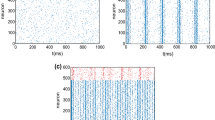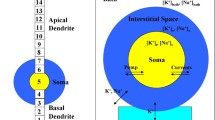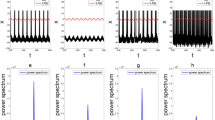Abstract
In this paper, based on the modified FitzHugh–Nagumo (FHN) neuron model, the effects of high–low-frequency (HLF) electromagnetic radiation on vibrational resonance (VR) in single neuron and two coupled neurons system are investigated, respectively. It is found that the VR can be observed in a single modified FHN neuron model with or without considering the HLF electromagnetic radiation, and the HLF electromagnetic radiation weakens the VR. When coupling between two modified FHN neurons is considered, the multiple vibrational resonances (MVR) can be detected. However, the input of HLF electromagnetic radiation makes the maximum area and intensity of the system response amplitude smaller, ultimately weakening the MVR. Further analysis shows that the HLF electromagnetic radiation caused a decrease in the number and amplitude of neuronal discharges, making the system less sensitive to the low-frequency signal, thus weakening the VR. In addition, the effects of system parameters such as the amplitude and frequency of HLF electromagnetic radiation and the strength of coupling between two neurons on the Fourier coefficients are investigated, and it is found that these parameters can also induce changes in the number of resonance peaks, resulting in VR and MVR. Systems that exhibit MVR have better ability to detect and propagate signals under HLF electromagnetic radiation. And the HLF electromagnetic radiation plays an important role in weakening the VR in neuronal systems.
Graphical abstract




















Similar content being viewed by others
Data availability
The datasets generated during and/or analyzed during the current study are available from the corresponding author on reasonable request.
References
S. Fauve, F. Heslot, Stochastic resonance in a bistable system. Phys. Lett. A 97(1–2), 5–7 (1983). https://doi.org/10.1016/0375-9601(83)90086-5
N. Takahashi, Y. Hanyu, T. Musha, R. Kubo, G. Matsumoto, Global bifurcation structure in periodically stimulated giant axons of squid. Phys. D 43(2–3), 318–334 (1990). https://doi.org/10.1016/0167-2789(90)90140-K
P. Hänggi, Stochastic resonance in biology how noise can enhance detection of weak signals and help improve biological information processing. ChemPhysChem 3(3), 285–290 (2002). https://doi.org/10.1002/1439-7641(20020315)3:3<285::AID-CPHC285>3.0.CO;2-A
R. Benzi, A. Sutera, A. Vulpiani, The mechanism of stochastic resonance. J. Phys. A: Math. Gen. 14(11), 453 (1981). https://doi.org/10.1088/0305-4470/14/11/006
R. Benzi, Stochastic resonance: from climate to biology. Nonlinear Process. Geophys. 17(5), 431–441 (2010). https://doi.org/10.5194/npg-17-431-2010
J. Gao, J. Yang, D. Huang, H. Liu, S. Liu, Experimental application of vibrational resonance on bearing fault diagnosis. J. Braz. Soc. Mech. Sci. Eng. 41, 1–13 (2019). https://doi.org/10.1007/s40430-018-1502-0
V.N. Chizhevsky, G. Giacomelli, Experimental and theoretical study of vibrational resonance in a bistable system with asymmetry. Phys. Rev. E 73(2), 022103 (2006). https://doi.org/10.1103/PhysRevE.73.022103
M.D. McDonnell, D. Abbott, What is stochastic resonance? definitions, misconceptions, debates, and its relevance to biology. PLoS Comput. Biol. 5(5), 1000348 (2009). https://doi.org/10.1371/journal.pcbi.1000348
B. Hutcheon, Y. Yarom, Resonance, oscillation and the intrinsic frequency preferences of neurons. Trends Neurosci. 23(5), 216–222 (2000). https://doi.org/10.1016/S0166-2236(00)01547-2
B.J. Gluckman, T.I. Netoff, E.J. Neel, W.L. Ditto, M.L. Spano, S.J. Schiff, Stochastic resonance in a neuronal network from mammalian brain. Phys. Rev. Lett. 77(19), 4098 (1996). https://doi.org/10.1103/PhysRevLett.77.4098
D. Guo, C. Li, Stochastic resonance in hodgkin-huxley neuron induced by unreliable synaptic transmission. J. Theor. Biol. 308, 105–114 (2012). https://doi.org/10.1016/j.jtbi.2012.05.034
A. Bulsara, E.W. Jacobs, T. Zhou, F. Moss, L. Kiss, Stochastic resonance in a single neuron model: Theory and analog simulation. J. Theor. Biol. 152(4), 531–555 (1991). https://doi.org/10.1016/S0022-5193(05)80396-0
A. Longtin, Stochastic resonance in neuron models. J. Stat. Phys. 70, 309–327 (1993). https://doi.org/10.1007/BF01053970
D. Nozaki, D.J. Mar, P. Grigg, J.J. Collins, Effects of colored noise on stochastic resonance in sensory neurons. Phys. Rev. Lett. 82(11), 2402 (1999). https://doi.org/10.1103/PhysRevLett.82.2402
J.J. Collins, C.C. Chow, T.T. Imhoff, Stochastic resonance without tuning. Nature 376, 236–238 (1995)
M., P, Stochastic resonance on excitable small-world networks via a pacemaker. Phys 76(6), 066203 (2007) https://doi.org/10.1103/PhysRevE.76.066203
S.M. Bezrukov, I. Vodyanoy, Noise-induced enhancement of signal transduction across voltage-dependent ion channels. Nature 378(6555), 362–364 (1995). https://doi.org/10.1038/378362a0
Y. Xu, Y. Guo, G. Ren, J. Ma, Dynamics and stochastic resonance in a thermosensitive neuron. Appl. Math. Comput. 385, 125427 (2020). https://doi.org/10.1016/j.amc.2020.125427
A.R. Bulsara, A.J. Maren, G. Schmera, Single effective neuron: Dendritic coupling effects and stochastic resonance. Biol. Cybern. 70(2), 145–156 (1993). https://doi.org/10.1007/BF00200828
T. Palabas, J.J. Torres, M. Perc, M. Uzuntarla, Double stochastic resonance in neuronal dynamics due to astrocytes. Chaos, Solitons Fractals 168, 113140 (2023). https://doi.org/10.1016/j.chaos.2023.113140
G. Wang, Y. Wu, F. Xiao, Z. Ye, Y. Jia, Non-gaussian noise and autapse-induced inverse stochastic resonance in bistable izhikevich neural system under electromagnetic induction. Phys. A 598, 127274 (2022). https://doi.org/10.1016/j.physa.2022.127274
N. Salansky, A. Fedotchev, A. Bondar, Responses of the nervous system to low frequency stimulation and eeg rhythms: clinical implications. Neurosci. Biobehav. Rev. 22(3), 395–409 (1998). https://doi.org/10.1016/S0149-7634(97)00029-8
Q. Lu, H. Gu, Z. Yang, X. Shi, L. Duan, Y. Zheng, Dynamics of firing patterns, synchronization and resonances in neuronal electrical activities: experiments and analysis. Acta. Mech. Sin. 24(6), 593–628 (2008). https://doi.org/10.1007/s10409-008-0204-8
Y. Eroglu, M. Yildirim, A. Cinar, mrmr-based hybrid convolutional neural network model for classification of alzheimer’s disease on brain magnetic resonance images. Int. J. Imaging Syst. Technol. 32(2), 517–527 (2022). https://doi.org/10.1002/ima.22632
J. Zhu, C. Kong, L. X., Subthreshold and suprathreshold vibrational resonance in the fitzhugh-nagumo neuron model. Phys. Rev. E 94(3), 032208 (2016) https://doi.org/10.1103/PhysRevE.94.032208
E. Ullner, A. Zaikin, J. García-Ojalvo, R. Báscones, J. Kurths, Vibrational resonance and vibrational propagation in excitable systems. Phys. Lett. A 312(5–6), 348–354 (2003). https://doi.org/10.1016/S0375-9601(03)00681-9
J.P. Baltanás, L. López, I.I. Blechman, P.S. Landa, A. Zaikin, J. Kurths, M.A.F. Sanjuán, Experimental evidence, numerics, and theory of vibrational resonance in bistable systems. Phys. Rev. E 67(6), 066119 (2003). https://doi.org/10.1103/PhysRevE.67.066119
P.S. Landa, Vibrational resonance. J. Phys. A: Math. Gen. 33(45), 433 (2000)
S. Jeyakumari, V. Chinnathambi, S. Rajasekar, M.A.F. Sanjuan, Single and multiple vibrational resonance in a quintic oscillator with monostable potentials. Phys. Rev. E 80(4), 046608 (2009). https://doi.org/10.1103/PhysRevE.80.046608
A. Calim, A. Longtin, M. Uzuntarla, Vibrational resonance in a neuron-astrocyte coupled model. Philos. Trans. R. Soc. A 379(2198), 20200267 (2021). https://doi.org/10.1098/rsta.2020.0267
B. Deng, J. Wang, X. Wei, Effect of chemical synapse on vibrational resonance in coupled neurons. Chaos 19(1), 013117 (2009). https://doi.org/10.1063/1.3076396
B. Deng, J. Wang, X. Wei, K.M. Tsang, W.L. Chan, Vibrational resonance in neuron populations. Chaos 20(1), 013113 (2010). https://doi.org/10.1063/1.3324700
A. Calim, T. Palabas, M. Uzuntarla, Stochastic and vibrational resonance in complex networks of neurons. Philos. Trans. R. Soc. A 379(2198), 20200236 (2021). https://doi.org/10.1098/rsta.2020.0236
S.N. Agaoglu, A. Calim, P. Hövel, M. Ozer, M. Uzuntarla, Vibrational resonance in a scale-free network with different coupling schemes. Neurocomputing 325, 59–66 (2019). https://doi.org/10.1016/j.neucom.2018.09.070
A.A. Zaikin, L. López, J.P. Baltanás, J. Kurths, M.A.F. Sanjuán, Vibrational resonance in a noise-induced structure. Phys. Rev. E 66(1), 011106 (2002). https://doi.org/10.1103/PhysRevE.66.011106
C. Wang, K. Yang, S. Qu, Vibrational resonance in a discrete neuronal model with time delay. Int. J. Mod. Phys. B 28(16), 1450103 (2014). https://doi.org/10.1142/S0217979214501033
D. Hu, J. Yang, X. Liu, Delay-induced vibrational multiresonance in fitzhugh-nagumo system. Commun. Nonlinear Sci. Numer. Simul. 17(2), 1031–1035 (2012). https://doi.org/10.1016/j.cnsns.2011.05.041
L. Yang, W. Liu, M. Yi, C. Wang, Q. Zhu, X. Zhan, Y. Jia, Vibrational resonance induced by transition of phase-locking modes in excitable systems. Phys. Rev. E 86(1), 016209 (2012). https://doi.org/10.1103/PhysRevE.86.016209
L. Chua, Memristor-the missing circuit element. IEEE Trans. Circuit Theory 18(5), 507–519 (1971). https://doi.org/10.1109/TCT.1971.1083337
D.B. Strukov, G.S. Snider, D.R. Stewart, R.S. Williams, The missing memristor found. Nature 453(7191), 80–83 (2008). https://doi.org/10.1038/nature06932
C. Wang, M. Lv, A. Alsaedi, J. Ma, Synchronization stability and pattern selection in a memristive neuronal network. Chaos 27(11), 113108 (2017). https://doi.org/10.1063/1.5004234
K. Rajagopal, F. Parastesh, H. Azarnoush, B. Hatef, S. Jafari, V. Berec, Spiral waves in externally excited neuronal network: Solvable model with a monotonically differentiable magnetic flux. Chaos 29(4), 043109 (2019). https://doi.org/10.1063/1.5088654
W. Yao, C. Wang, J. Cao, Y. Sun, C. Zhou, Hybrid multisynchronization of coupled multistable memristive neural networks with time delays. Neurocomputing 363, 281–294 (2019). https://doi.org/10.1016/j.neucom.2019.07.014
C. Wang, L. Xiong, J. Sun, W. Yao, Memristor-based neural networks with weight simultaneous perturbation training. Nonlinear Dyn. 95(4), 2893–2906 (2019). https://doi.org/10.1007/s11071-018-4730-z
D.B. SStrukov, Endurance-write-speed tradeoffs in nonvolatile memories. Appl. Phys. A 122, 1–4 (2016). https://doi.org/10.1007/s00339-016-9841-0
S. Kvatinsky, M. Ramadan, E.G. Friedman, A. Kolodny, Vteam: A general model for voltage-controlled memristors. IEEE Trans. Circuits Syst. II Express Briefs 62(8), 786–790 (2015). https://doi.org/10.1109/TCSII.2015.2433536
J. Ruan, K. Sun, J. Mou, S. He, L. Zhang, Fractional-order simplest memristor-based chaotic circuit with new derivative. Eur. Phys. J. Plus 133, 1–12 (2018). https://doi.org/10.1140/epjp/i2018-11828-0
L. Zhou, C. Wang, L. Zhou, A novel no-equilibrium hyperchaotic multi-wing system via introducing memristor. Int. J. Circuit Theory Appl. 46(1), 84–98 (2018). https://doi.org/10.1002/cta.2339
C. Wang, X. Liu, H. Xia, Multi-piecewise quadratic nonlinearity memristor and its 2 n-scroll and 2 n+ 1-scroll chaotic attractors system. Chaos 27(3), 033114 (2017). https://doi.org/10.1063/1.4979039
F. Yu, Z. Zhang, L. Liu, H. Shen, Y. Huang, C. Shi, S. Cai, Y. Song, S. Du, Q. Xu, Secure communication scheme based on a new 5d multistable four-wing memristive hyperchaotic system with disturbance inputs. Complexity 2020, 1–16 (2020). https://doi.org/10.1155/2020/5859273
X. Xie, S. Wen, Z. Zeng, T. Huang, Memristor-based circuit implementation of pulse-coupled neural network with dynamical threshold generators. Neurocomputing 284, 10–16 (2018). https://doi.org/10.1016/j.neucom.2018.01.024
S. Wen, X. Xie, Z. Yan, T. Huang, Z. Zeng, General memristor with applications in multilayer neural networks. Neural Netw. 103, 142–149 (2018). https://doi.org/10.1016/j.neunet.2018.03.015
D. Soudry, D. Di Castro, A. Gal, A. Kolodny, S. Kvatinsky, Memristor-based multilayer neural networks with online gradient descent training. IEEE Trans Neural Netw Learn Syst 26(10), 2408–2421 (2015). https://doi.org/10.1109/TNNLS.2014.2383395
Y.V. Pershin, M. Di Ventra, Experimental demonstration of associative memory with memristive neural networks. Neural Netw. 23(7), 881–886 (2010). https://doi.org/10.1016/j.neunet.2010.05.001
G. Ren, Y. Xu, C. Wang, Synchronization behavior of coupled neuron circuits composed of memristors. Nonlinear Dyn. 88, 893–901 (2017). https://doi.org/10.1007/s11071-016-3283-2
A. Thomas, Memristor-based neural networks. J. Phys. D Appl. Phys. 46(9), 093001 (2013). https://doi.org/10.1088/0022-3727/46/9/093001
J. Ma, F. Wu, C. Wang, Synchronization behaviors of coupled neurons under electromagnetic radiation. Int. J. Mod. Phys. B 31(2), 1650251 (2017). https://doi.org/10.1142/S0217979216502519
Y. Xu, H. Ying, Y. Jia, J. Ma, T. Hayat, Autaptic regulation of electrical activities in neuron under electromagnetic induction. Sci. Rep. 7(1), 1–12 (2017). https://doi.org/10.1038/srep43452
Y. Xu, Y. Jia, H. Wang, Y. Liu, P. Wang, Y. Zhao, Spiking activities in chain neural network driven by channel noise with field coupling. Nonlinear Dyn. 95, 3237–3247 (2019). https://doi.org/10.1007/s11071-018-04752-2
Y. Xu, J. Ma, X. Zhan, L. Yang, Y. Jia, Temperature effect on memristive ion channels. Cogn. Neurodyn. 13, 601–611 (2019). https://doi.org/10.1007/s11571-019-09547-8
M. Lv, C. Wang, G. Ren, J. Ma, X. Song, Model of electrical activity in a neuron under magnetic flow effect. Nonlinear Dyn. 85, 1479–1490 (2016). https://doi.org/10.1007/s11071-016-2773-6
C.N. Takembo, A. Mvogo, H.P. Ekobena Fouda, T.C. Kofané, Effect of electromagnetic radiation on the dynamics of spatiotemporal patterns in memristor-based neuronal network. Nonlinear Dyn. 95, 1067–1078 (2019). https://doi.org/10.1007/s11071-018-4616-0
C.N. Takembo, A. Mvogo, H.P. Ekobena Fouda, T.C. Kofané, Wave pattern stability of neurons coupled by memristive electromagnetic induction. Nonlinear Dyn. 96, 1083–1093 (2019). https://doi.org/10.1007/s11071-019-04841-w
J. Ma, Y. Wang, C. Wang, Y. Xu, G. Ren, Mode selection in electrical activities of myocardial cell exposed to electromagnetic radiation. Chaos, Solitons Fractals 99, 219–225 (2017). https://doi.org/10.1016/j.chaos.2017.04.016
Y. Xu, Y. Jia, J. Ma, A. Alsaedi, B. Ahmad, Synchronization between neurons coupled by memristor. Chaos, Solitons Fractals 104, 435–442 (2017). https://doi.org/10.1016/j.chaos.2017.09.002
M. Ge, L. Lu, Y. Xu, R. Mamatimin, Q. Pei, Y. Jia, Vibrational mono-/bi-resonance and wave propagation in fitzhugh-nagumo neural systems under electromagnetic induction. Chaos, Solitons Fractals 133, 109645 (2020). https://doi.org/10.1016/j.chaos.2020.109645
F. Wu, C. Wang, W. Jin, J. Ma, Dynamical responses in a new neuron model subjected to electromagnetic induction and phase noise. Phys. A 469, 81–88 (2017). https://doi.org/10.1016/j.physa.2016.11.056
F. Li, C. Yao, The infinite-scroll attractor and energy transition in chaotic circuit. Nonlinear Dyn. 84, 2305–2315 (2016). https://doi.org/10.1007/s11071-016-2646-z
L. Lu, Y. Jia, M. Ge, Y. Xu, A. Li, Inverse stochastic resonance in hodgkin-huxley neural system driven by gaussian and non-gaussian colored noises. Nonlinear Dyn. 100, 877–889 (2020). https://doi.org/10.1007/s11071-020-05492-y
C.N. Takembo, A. Mvogo, H.P. Ekobena Fouda, T.C. Kofané, Modulated wave formation in myocardial cells under electromagnetic radiation. Int. J. Mod. Phys. B 32(14), 1850165 (2018). https://doi.org/10.1142/S0217979218501655
B. Pol, Lxxxviii. on “relaxation-oscillations. Lond. Edinb. Dublin philos. mag. j. sci. 2(11), 978–992 (1926) https://doi.org/10.1080/14786442608564127
R. FitzHugh, Impulses and physiological states in theoretical models of nerve membrane. Biophys. J . 1(6), 445–466 (1961). https://doi.org/10.1016/S0006-3495(61)86902-6
J. Nagumo, S. Arimoto, S. Yoshizawa, An active pulse transmission line simulating nerve axon. Proc. IRE 50(10), 2061–2070 (1962). https://doi.org/10.1109/JRPROC.1962.288235
H. Yu, J. Wang, B. Deng, X. Wei, Y. Che, Y.K. Wong, W.L. Chan, K.M. Tsang, Adaptive backstepping sliding mode control for chaos synchronization of two coupled neurons in the external electrical stimulation. Commun. Nonlinear Sci. Numer. Simul. 17(3), 1344–1354 (2012). https://doi.org/10.1016/j.cnsns.2011.07.009
S. Baigent, Cells coupled by voltage-dependent gap junctions: the asymptotic dynamical limit. Biosystems 68(2–3), 213–222 (2003). https://doi.org/10.1016/S0303-2647(02)00097-7
S. Zhou, W. Lin, Eliminating synchronization of coupled neurons adaptively by using feedback coupling with heterogeneous delays. Chaos 31(2), 023114 (2021). https://doi.org/10.1063/5.0035327
M. Ge, Y. Jia, L. Lu, Y. Xu, H. Wang, Y. Zhao, Propagation characteristics of weak signal in feedforward izhikevich neural networks. Nonlinear Dyn. 99, 2355–2367 (2020). https://doi.org/10.1007/s11071-019-05392-w
G. Wang, D. Yu, Q. Ding, T. Li, Y. Jia, Effects of electric field on multiple vibrational resonances in hindmarsh-rose neuronal systems. Chaos, Solitons Fractals 150, 111210 (2021). https://doi.org/10.1016/j.chaos.2021.111210
V. Baysal, E. Yilmaz, Effects of electromagnetic induction on vibrational resonance in single neurons and neuronal networks. Phys. A 537, 122733 (2020). https://doi.org/10.1016/j.physa.2019.122733
T.O. Roy-Layinde, K.A. Omoteso, B.A. Oyero, J.A. Laoye, U.E. Vincent, Vibrational resonance of ammonia molecule with doubly singular position-dependent mass. Eur. Phys. J. B 95(5), 80 (2022). https://doi.org/10.1140/epjb/s10051-022-00342-9
C. Dong, Y. Lan, Organization of spatially periodic solutions of the steady kuramoto-sivashinsky equation. Commun. Nonlinear Sci. Numer. Simul. 19(6), 2140–2153 (2014). https://doi.org/10.1016/j.cnsns.2013.09.040
M. Wechselberger, Canards. Scholarpedia 2(4), 1356 (2007). https://doi.org/10.4249/scholarpedia.1356
X.X. Wu, C. Yao, J. Shuai, Enhanced multiple vibrational resonances by na+ and k+ dynamics in a neuron model. Sci. Rep. 5(1), 1–10 (2015). https://doi.org/10.1038/srep07684
H.G. Liu, X.L. Liu, J.H. Yang, M.A.F. Sanjuán, G. Cheng, Detecting the weak high-frequency character signal by vibrational resonance in the duffing oscillator. Nonlinear Dyn. 89, 2621–2628 (2017). https://doi.org/10.1007/s11071-017-3610-2
Y. Xu, Y. Jia, M. Ge, L. Lu, L. Yang, X. Zhan, Effects of ion channel blocks on electrical activity of stochastic hodgkin-huxley neural network under electromagnetic induction. Neurocomputing 283, 196–204 (2018). https://doi.org/10.1016/j.neucom.2017.12.036
Acknowledgements
This work was supported by the National Natural Science Foundation of China (No. 61966022), the Natural Science Foundation Key Project of Gansu Province (No. 23JRRA860), the Natural Science Foundation of Gansu Province (No. 23JRRA913), and the key talent project of Gansu Province.
Author information
Authors and Affiliations
Contributions
All authors have contributed to the study conception and design. Material preparation, data collection, and analysis were performed by Kaijun Wu and Jiawei Li. The first draft of the manuscript was written by Jiawei Li and all authors commented on previous versions of the manuscript. All authors read and approved the final manuscript.
Corresponding author
Ethics declarations
Conflict of interest
The authors have no relevant financial or non-financial interests to disclose.
Rights and permissions
Springer Nature or its licensor (e.g. a society or other partner) holds exclusive rights to this article under a publishing agreement with the author(s) or other rightsholder(s); author self-archiving of the accepted manuscript version of this article is solely governed by the terms of such publishing agreement and applicable law.
About this article
Cite this article
Wu, K., Li, J. Effects of high–low-frequency electromagnetic radiation on vibrational resonance in FitzHugh–Nagumo neuronal systems. Eur. Phys. J. B 96, 126 (2023). https://doi.org/10.1140/epjb/s10051-023-00594-z
Received:
Accepted:
Published:
DOI: https://doi.org/10.1140/epjb/s10051-023-00594-z




